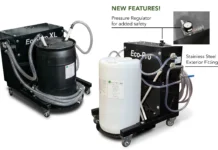“Made in the USA” is a concept that is especially topical as the nation feels the lasting effects of the pandemic-spurred supply chain meltdown. Companies are rethinking their offshoring decisions and bringing material and part sourcing and manufacturing back to the US. The states themselves are working to facilitate that effort, along with helping the country’s existing manufacturers meet their workforce, construction/expansion and modernization goals.
In the first quarter of 2022 alone, based on a cursory survey of press releases from the states, at least $350 million has been positioned to aid domestic manufacturing. Here is a high-level look at the top five areas in which US manufacturers are seeing financial support from our union of states for workforce development, new plants or plant expansions, and Industry 4.0 improvements.
Apprenticeships
In Maine and in Montana, apprenticeships are getting a financial leg up from state government.
Gov. Janet Mills of Maine announced that the Maine Department of Labor will make up to $12 million in grant funding available to businesses to expand apprenticeships. The new grants can be used by businesses or industry associations to partner with Maine Department of Labor’s Registered Apprenticeship Program to develop new apprenticeship programs or expand existing ones.
In Montana, Gov. Greg Gianforte announced the award of $605,000 to businesses and nonprofits in the state for skills-based workforce training and apprenticeship programs. In addition, the governor announced a $6 million grant to Accelerate Montana to establish a series of retraining and upskilling programs in sectors including manufacturing.
Business incentives
On the Atlantic coast and in the Upper Midwest, states are offering financial incentives to new and expanding manufacturing plants.
In Massachusetts, Lt. Gov. Karyn Polito and Housing and Economic Development Secretary Mike Kennealy announced a $1.5 million grant from the Massachusetts Manufacturing Innovation Initiative to 6K, a company that produces advanced materials used in additive manufacturing and batteries. The grant will fund advancement of microwave technology for recycling scrap materials and metal powders.
Eli Lilly will build a new pharmaceutical manufacturing plant in Concord, North Carolina, thanks, in part, to a Job Development Investment Grant from that state for potential reimbursement to Eli Lilly of up to $12.1 million over 12 years to support the company’s estimated 600 new jobs at the plant.
Pennsylvania’s Gov. Tom Wolf announced that pet health and wellness company Spot & Tango will open a manufacturing facility in Lehigh County, creating 100 new jobs. In addition to other support and incentives, Spot & Tango was awarded a $150,000 workforce development grant to help train workers.
As LG Energy Solution builds an electric vehicle battery plant in Holland, Michigan, it will enjoy millions of dollars’ worth of incentives, including a $10 million Jobs Ready Michigan program grant from the state. A community college and a job training organization also are providing funding and services.
Manufacturing 4.0 improvements
Companies in Iowa and Massachusetts are getting support to improve their operations and advance their smart manufacturing efforts.
Iowa’s Economic Development Authority announced $22 million in Manufacturing 4.0 Workforce Innovation grants for 46 companies in the state, for helping manufacturers invest in advanced technologies. Another $1.9 million was awarded in Technology Investment grants, for 37 companies that aspire to having more smart technology integration in their plants.
In Massachusetts, the Baker-Polito Administration kicked off the Massachusetts Manufacturing Accelerate Program by awarding over $2 million to 13 manufacturers across the Commonwealth to help prepare the businesses to meet the demands of Industry 4.0. The administration also awarded Massachusetts Manufacturing Innovation Initiative grants, to spur innovation, to three companies in the state that produce “smart textiles,” tech-integrated apparel and wearable technology.
Training in high schools, colleges and universities
Five US states have anted up the bucks for school-based training of the next generation of workers.
In Florida, Gov. Ron DeSantis awarded $9.7 million to aid manufacturing in Osceola County, including a $3.7 million grant to Valencia College for new programs focused on robotics technician training for semiconductor industries.
The Governor’s Workforce Cabinet and Conexus Indiana launched a $500,000 grant program to support Indiana high schools in preparing students for advanced manufacturing careers.
Nevada Gov. Steve Sisolak helped the College of Southern Nevada launch an advanced manufacturing rapid response program with a $2 million Workforce Innovations for a New Nevada grant.
In Ohio, Youngstown State University is the beneficiary of a $250,000 award to support industry training and credentials for advanced manufacturing and other technology skills, as part of the state’s Individual Microcredential Assistance Program.
Gov. Tom Wolf of Pennsylvania announced new funding, through the Manufacturing PA Training-to-Career Program, of nearly $100,000 to expand the manufacturing program at McDowell Senior High School. The governor also awarded nearly $200,000, through the same Program, to Northampton Community College to develop a Pathways to Manufacturing program in the Lehigh Valley.
Workforce in general
Many states are backing workforce development through financial support, including Arkansas, Missouri, Ohio, Oregon, Pennsylvania and Wisconsin.
Arkansas’s Gov. Asa Hutchinson awarded $8 million in grants to organizations and partnerships to boost development of skilled workers. The grants include $1.9 million to The University of Arkansas at Little Rock for a cyber-learning center, $226,000 to North Arkansas Community College to expand truck driving and manufacturing programs, $1.2 million for a welding and composites manufacturing program at Arkansas State University, over $400,000 to the Clark County Workforce Training Group to promote millwright and industrial maintenance training, and nearly $250,000 to the Arkansas Regional Innovation Hub for energy efficiency, industrial maintenance, roofing and HVAC training programs.
In Missouri, Gov. Mike Parson announced a grant from the MoExcels Workforce initiative to help fund a state-of-the-art lab in Columbia, which includes the Mechatronics Center of Excellence, designed to prepare students to be technicians for manufacturing facility equipment.
In Ohio, the Mahoning Valley Manufacturers Coalition and Raise the Bar Hancock County, a workforce development partner, are among the recipients of $2.58 million in Industry Sector Partnership grants for the benefit of in-demand industry sectors including manufacturing.
Oregon lawmakers passed Senate Bill 1545, known as Future Ready Oregon, which puts $200 million into new and existing programs for job training, apprenticeships and education. The investment comes at the request of Governor Kate Brown and prioritizes manufacturing, among other sectors.
Pennsylvania’s governor announced $335,000 in funding in Southwestern Pennsylvania to raise awareness of manufacturing industry job opportunities. Wolf also launched an initiative, supported by a $250,000 Industry Partnership Grant, to provide training for emerging jobs in agribusiness in southcentral Pennsylvania. The initiative includes support for agribusiness-related manufacturing education at Shippensburg University, HACC, Central Pennsylvania’s Community College and the Harrisburg University of Science and Technology.
In Wisconsin, Gov. Tony Evers announced three workforce development grants. A $10 million Workforce Innovation Grant goes to Chippewa Valley Technical College to address manufacturing workforce development. $3.1 million in funding from Wisconsin Fast Forward is available for employer-led, customized worker training grants, open to all industry sectors. And a $5.6 million Workforce Innovation Grant will help Gateway Technical College, the YWCA of Southeast Wisconsin and other partners guide students to earn a high school diploma, seek additional workforce training and enter the manufacturing workforce, among other industry sectors.
If the states have anything to say about it, with their nearly a quarter of a billion dollars in grants and support for manufacturing during Q1 2022, “Made in the USA” will surely thrive and flourish.





